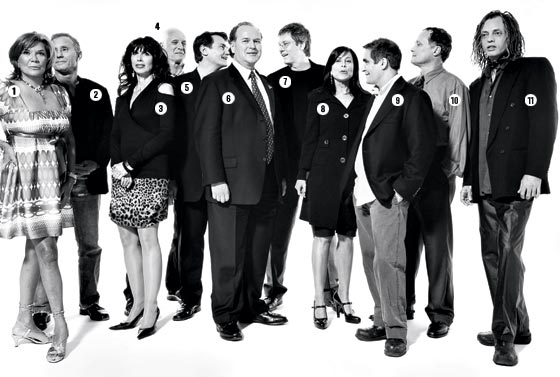
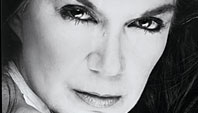
1. CARMEN D’ALESSIO, 59
Then: Public Relations. “I created Studio 54!” says D’Alessio. “I’m the most important person to talk to.” According to the modest Peruvian, she brought Schrager and Rubell “hand-in-hand from the boroughs to the Big Apple,” and presented them at a preopening dinner attended by Warhol, Halston, and Calvin Klein. She found them Armani suits at Barneys. And then she put the club on the map by throwing parties like the one where Bianca Jagger rode in on a white horse, or Valentino got to act as the ringleader of real circus animals, or Armani was fêted with a drag-queen ballet. She also popped out of her own birthday cake in a skimpy gold lamé Norma Kamali bathing suit. Her breast popped out later, too.
Now: Club Owner. Unlike her Studio cohorts (most of whom she didn’t mingle with because she was a “little diva,” she says), D’Alessio has never lost a taste for nightlife. “Studio didn’t impress me,” she says. “I’ve always been a jet-setter. Andy Warhol said I am the jet-setter.” Now, after promoting every nightclub in the city, from Limelight and Tunnel to Cain and Plumm, she’s fulfilling a dream and opening a restaurant-bar-lounge of her own back home in Lima, Peru.
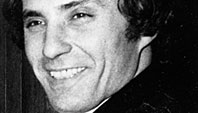
2. IAN SCHRAGER, 60
(See Q&A here.)
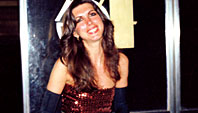
3. MYRA SCHEER, 56
Then: Executive Assistant. After several months of going to Studio as a customer, she was hired as Rubell and Schrager’s gal Friday. “I would get on the phone with Andy Warhol, Liza Minnelli, Diana Ross, Halston, and invite them to Steve’s ‘backdoor’ parties,” which were private parties held behind a backdrop from 10 p.m. to midnight. “Then at midnight the backdrop would lift and they’d become part of the club.”
Now: Fund-Raising Consultant. “I did nightclub PR until I had an awakening: I didn’t want to drink anymore.” She went into beauty and health PR, “kind of the antithesis of disco,” and works for nonprofits like the Rainforest Foundation Fund. “Now I’d rather work out to disco music than dance to it.”

4. R. SCOTT BROMLEY, 68
Then: Architect. D’Alessio asked Bromley to drop by to see the raw space. “I walked in, and all of a sudden it hit,” says Bromley. “I said, ‘You know, everyone wants a little bit of fame. So we’ll rip out all the seats and turn the stage into the dance floor.’ They loved the idea. We were designing it on napkins.” They hired a crew of tough Irish kids from the neighborhood and hammered and nailed it all together themselves.
Now: Architect. Approaching 70, Bromley now only goes out to eat. (“Your legs go out. It just fades.”) But he’s still a clubber at heart: “The scuttlebutt on my block was that there would be a new nightclub moving in, and all the people my age were pooh-poohing it. ‘We don’t want the traffic. We don’t want the noise.’ I thought, How wonderful! It will liven up the place. We’ll have lots of kids!”
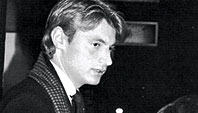
5. MARC BENECKE, 50
Then: Doorman. As a 19-year-old political-science student at Hunter College, he went with a friend to check out the club before it opened. “It was April. We walked in the door. I met Steve Rubell, and he asked me what I was doing for the summer. I said, ‘Nothing,’ and he said, ‘How would you like to work here?’”
Now: Real-Estate Broker. “After Studio closed, I didn’t realize the party had ended, and it took me a long time. Let’s put it this way: Now I only drink red wine.” He spent years running his own bars and restaurants in L.A., then, in 2000, he reconnected with Schrager to help open the Clift hotel in San Francisco. This year, he changed careers, becoming a residential real-estate broker. What happened? “You’ll have to ask Ian.” Are you friendly? “We speak. I was very close with Steve. I miss Steve.”
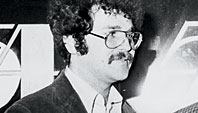
6. CHUCK GARELICK, 49
Then: Head of Security. Garelick watched out for all the workers—especially Benecke, who was constantly in danger of being slugged by people he refused to let in. When the crowd outside got too big, Garelick and his men would link arms in a V formation and plunge in to swoop up Benecke’s chosen revelers and escort them inside.
Now: Managing Director of GSS Security Services. Though he managed security for the Palladium in the eighties, Garelick has permanently gotten out of the nightclub business—his firm works with special events, hotels, and stores. “I like daylight,” he says. “And the nightclub business has changed. It used to be that if you banged into someone in a club, you’d turn around, say, ‘Excuse me. Sorry.’ They might even buy you a drink. Now it’s progressed to the point where if you bang into someone and say, ‘Excuse me,’ they’ll shoot you.”
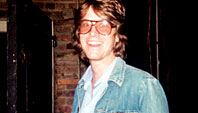
7. MICHAEL OVERINGTON, 53
Then: General Manager. Days before the club opened, Overington talked his way into a $3-an-hour janitor job, and then worked his way up. “Maybe a few busboys like Lenny [Miestorm] partied, but the doormen, the people who dealt with money, the technical people handling sets in the back, they didn’t party. We were all there to work really long hours. And we all made really good money. It’s almost like asking the cast of a major show like A Chorus Line, ‘Well, did you guys really go out and party all the time?’ No. We were all really serious about creating a great show.”
Now: Vice-Chairman, Ian Schrager Co. Overington, whose wife is a former Studio coat-check girl, is still Schrager’s right-hand man. When Rubell passed away just months after the Royalton Hotel opened, “Ian had to kinda jump in to fill Stevie’s role [as the front man]. So I had to jump in to fill Ian’s role.” They went on to build the Paramount, the Delano, Mondrian, the Hudson, and the Gramercy Park Hotel, among others.
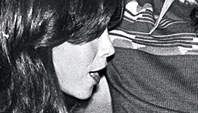
8. JOANNE HOROWITZ, 54
Then: Celebrity Wrangler. She got paid by the star. “Everybody was a different price,” she says. “Once in a while, Ian and I would argue because I thought Alice Cooper [$60] was worth as much as Sylvester Stallone [$80], but Ian thought no.”
Now: Kevin Spacey’s Manager.They didn’t meet at Studio 54, but they did strike up a friendship, and Horowitz helped the then-unknown actor get into the club. Horowitz did movie-studio and personal publicity before becoming Spacey’s full-time manager. “It’s just a different kind of hustle,” she says. “I still work 24/7.”
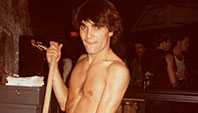
9. SCOTT TAYLOR, 50
Then: Bartender. “Steve wanted all big, gay, muscle-bound bartenders, and I was, like, this Jewish straight boy from Queens. But I was a really hard worker,” he says. On opening night, he just showed up and volunteered his services in coat check. The second night, he showed up again and was put behind the bar when another bartender, also named Scott, called in sick. “Then, at the end of the night,” he says, “when all the other guys went out dancing, I took out the garbage and mopped the floor. Steve was still like, ‘I don’t want him working here.’ But the other bartenders were like, ‘No, no, no. He’s staying!’” Rubell finally relented. “Steve said, ‘You’re okay. You blend in with the gray walls.’”
Now: Real-Estate Developer. After Studio, Taylor started a string of bars. Then, at age 40, “I just realized, ‘What the fuck? I’m sick of the kids and being drunk.’” In 2005, he started a real-estate development company; soon after, he married clothing designer Sylvia Heisel.
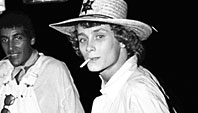
10. SCOTT NILSSON, 49
Then: Busboy. A ballet student at NYU, he’d arrived at Penn Station for the first time to be greeted by a man in a wedding dress, on roller skates, wearing a tiara, and carrying a fairy wand. “He smiled and blessed me on the way by.” When Bitterman (Scott’s last name then) got a job busing tables at Studio a few months later, he became friends with Rollerina, who was a club regular, and, rumor had it, a stockbroker. Nilsson also met his future (ex) wife on the Studio dance floor.
Now: Small-Business Owner.After Studio was busted, he left the city altogether, moving to Atlanta with his wife to run a nonprofit Baptist ministry, and changed his last name. “By about 1984, it was very hard to stay in touch,” he says. “You would catch up for two minutes and then you’d find out about all the people who had died. I stopped calling.” He and his wife divorced in 1988. In 2001 he remarried, to a 29-year-old choreographer. Recently he had an epiphany: “I’ve got about 30 years left, and if I’m going to try something different, it’s got to be now.” So he left the nonprofit to buy into a photography business that specializes in shooting dancers.
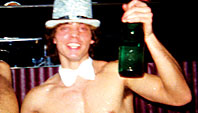
11. MIESTORM, 47
Then: Entertainer. A teenage art student from a farm in the Hamptons, Miestorm, or “Lenny 54,” as everyone called him then, was originally hired as a busboy and a part-time bartender, but soon gave up on the concept of work. “I told Steve on opening night, ‘Look at these little shorts I’m wearing. Do you expect me to pick up glasses and sweep the floors? I’m not going to do that. I’m going to entertain your guests.’” Rubell thought that was a great idea and gave him a quaalude, his first. Later that night, he says, he snorted coke with Andy Warhol, Divine, and Halston. He still got a regular paycheck.
Now: Aspiring Photographer. “Quaaludes, coke, shots of whiskey became my drugs of choice,” he says of the post–Studio 54 years, “and then maybe once in a while I’d pop a black beauty, a hit of blue-blotter acid, sometimes pink, sometimes yellow, sometimes magic mushrooms.” He lived in Brazil, Paris, Rome, Sicily, and California—where he spent two years working as a porn actor. During those years he had several “wake-up calls,” once literally waking up in a room full of naked people and finding that he couldn’t remember how he got there. Eventually, he decided “that I needed to get it together and not be high.”
SEE ALSO:
• Studio 54, Where Are You?
• Ian Schrager Explains it All